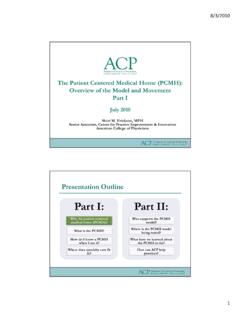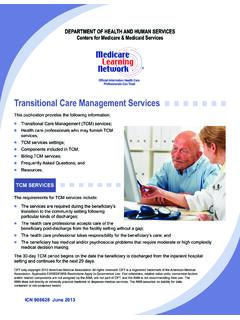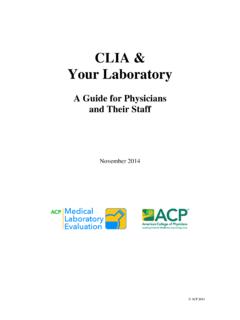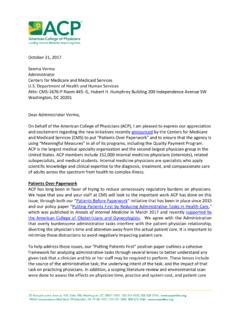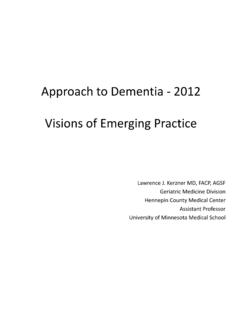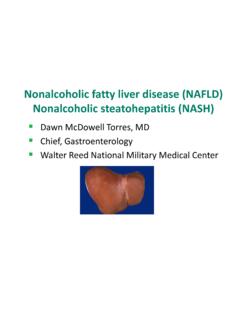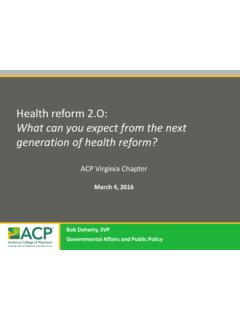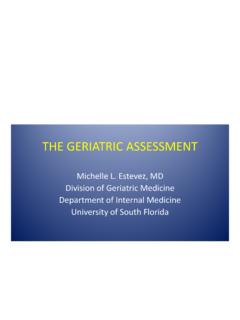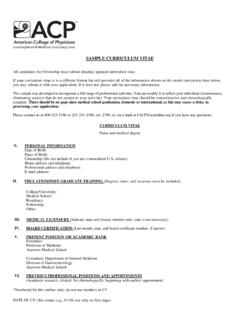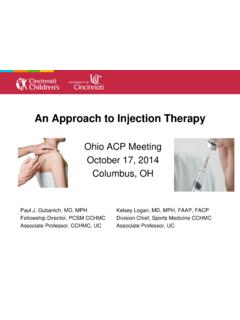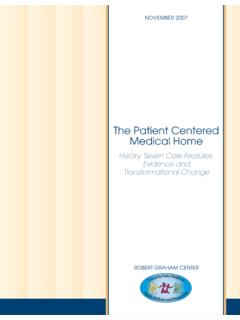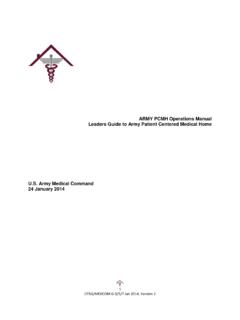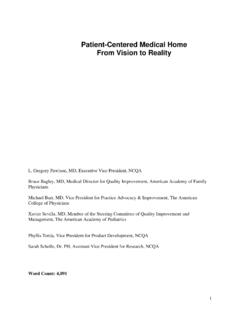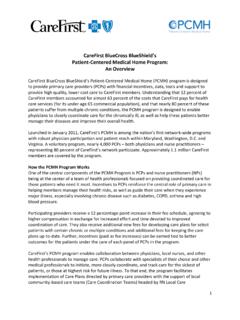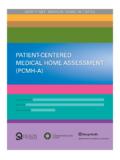Transcription of THE PATIENT-CENTERED MEDICAL HOME NEIGHBOR THE …
1 THEPATIENT-CENTEREDMEDICALHOMENEIGHBORTH EINTERFACE OF THEPATIENT-CENTEREDMEDICALHOME WITHSPECIALTY/SUBSPECIALTYPRACTICESA merican college of PhysiciansA Position Paper2010iTHEPATIENT-CENTEREDMEDICALHOME NEIGHBOR : THEINTERFACE OF THEPATIENT-CENTEREDMEDICALHOME WITHSPECIALTY/SUBSPECIALTYPRACTICESA Position Paper of theAmerican college of Physicians This policy paper, written by Neil Kirschner, PhD, and M. Carol Greenlee, MD, with significantcontributions from the following members (with the subspecialty society they represented inparentheses) of the american college of Physicians Council of Subspecialty Societies (CSS)Patient centered MEDICAL home (PCMH) Workgroup: Richard Honsinger Jr., MD, WorkgroupCo-Chair, (AAAAI): William Atchley Jr., MD, (SHM); Joel Brill, MD, (AGA); John Cox, MD,(ASCO); Lawrence D Angelo, MD (SAM); Tom DuBose, MD, (ASN); Daniel Ein, MD,(ACAAI); Pamela Hartzband, MD, (Endocrine Society); David Kaplan, MD, (AASLD), BruceLeff, MD, (AGS); Larry Martinelli, MD (ID Society); David May, MD (ACC); HoangmaiPham, MD, (SGIM); Larry Ray, MD, (SGIM); Joseph Sokolowski, MD, (ATS); and LawrenceWeisberg, MD, (RPA).
2 The paper was developed for and approved by the MEDICAL ServicesPolicy Committee of the american college of Physicians; Donald Hatton MD, Chair; ThomasTape, MD, Vice Chair; Sue Bornstein, MD; McKay B Crowley, MD; Stephan Fihn, MD;William Fox, MD; Robert Gluckman, MD; Stephen Kamholz, MD; Michael D. Leahy, MD;Joshua Lenchus, DO; Keith Michl, MD; John O Neill Jr. DO; and James W. Walker, MD. The paper was approved by the Board of Regents of the american college of Physicians onAugust 1, to cite this paper: american college of Physicians. The PATIENT-CENTERED MEDICAL home NEIGHBOR : TheInterface of the PATIENT-CENTERED MEDICAL home with Specialty/Subspecialty : american college of Physicians; 2010: Policy Paper. (Available from AmericanCollege of Physicians, 190 N. Independence Mall West, Philadelphia, PA 19106.) Copyright 2010 american college of Physicians. All rights reserved.
3 Individuals may photocopy all or parts of Position Papers for educational,not-for-profit uses. These papers may not be reproduced for commercial, for-profit use in anyform, by any means (electronic, mechanical, xerographic, or other) or held in any informationstorage or retrieval system without the written permission of the publisher. For questions about the content of this Position Paper, please contact ACP, Division ofGovernmental Affairs and Public Policy, Suite 700, 25 Massachusetts Avenue NW, Washington,DC 20001-7401; telephone 202-261-4500. To order copies of this Policy Paper, contact ACPC ustomer Service at 800-523-1546, extension 2600, or SummaryThe Council of Subspecialty Societies (CSS) of the american college ofPhysicians (ACP) established a Workgroup to specifically address the relationshipbetween the PATIENT-CENTERED MEDICAL home (PCMH) care model and specialty/subspecialty practices.
4 This policy paper, informed through the delib-erations of the Workgroup over the past 3 years and through feedback from thevarious societies represented in the CSS, addresses the interface between thePCMH and specialty/subspecialty practices and specifically: Highlights the important role of specialty and subspecialty practiceswithin the PCMH model Provides a definition of the PCMH NEIGHBOR (PCMH-N) concept Provides a framework to categorize interactions between PCMH andPCMH-N practices, which highlights that the specific type of inter-action is a function of the clinical situation being addressed, the professional judgment of the physicians involved, and the expressedneeds and preferences of the patient Offers a set of principles for the development of care coordinationagreements between PCMH and PCMH-N practices that are aspira-tional in nature and recognizes that their application should take intoaccount local community practice standards, administrative burden,practice size, and resources ( , paper-based vs.)
5 Use of an electronicmedical record system) Recognizes the importance of incentives, both financial and non-financial, to encourage PCMH-N involvement within the PCMH model Introduces the concept of a PCMH-N recognition policy paper makes the following specific recommendations:1. The ACP recognizes the importance of collaboration with spe-cialty and subspecialty practices to achieve the goal of improvedcare integration and coordination within the Patient-CenteredMedical home (PCMH) care delivery The ACP approves the following definition of a Patient-CenteredMedical home NEIGHBOR (PCMH-N) as it pertains to specialtyand subspecialty practices:A specialty/subspecialty practice recognized as a PCMH-N engages inprocesses that: Ensure effective communication, coordination, and integration withPCMH practices in a bidirectional manner to provide high-qualityand efficient care Ensure appropriate and timely consultations and referrals that com-plement the aims of the PCMH practice Ensure the efficient, appropriate, and effective flow of necessarypatient and care information Effectively guides determination of responsibility in co-managementsituations Support PATIENT-CENTERED care, enhanced care access, and high levels ofcare quality and safety Support the PCMH practice as the provider of whole-person primarycare to the patient and as having overall responsibility for ensuring thecoordination and integration of the care provided by all involved physi-cians and other health care Patient centered MEDICAL home Neighbor23.
6 The ACP approves the following framework to categorize inter-actions between PCMH and PCMH-N practices:The clinical interactions between the PCMH and the PCMH-N cantake the following forms: Preconsultation exchange intended to expedite/prioritize care, orclarify need for a referral Formal consultation to deal with a discrete question/procedure Co-management0 Co-management with Shared Management for the disease0 Co-management with Principal care for the disease0 Co-management with Principal care of the patient for a consum-ing illness for a limited period Transfer of patient to specialty PCMH for the entirety of The ACP approves the following aspirational guiding principlesfor the development-of-care coordination agreements betweenPCMH and PCMH-N practices. A care coordination agreement will define the types of referral, con-sultation, and co-management arrangements available. The care coordination agreement will specify who is accountable forwhich processes and outcomes of care within (any of) the referral, con-sultation, or co-management arrangements.
7 The care coordination agreement will specify the content of a patienttransition record/core data set, which travels with the patient in allreferral, consultation, and co-management arrangements. The care coordination agreement will define expectations regardingthe information content requirements, as well as the frequency andtimeliness of information flow within the referral process. This is abidirectional process reflecting the needs and preferences of both thereferring and consulting physician or other health care professional. The care coordination agreement will specify how secondary referralsare to be handled. The care coordination agreement will maintain a patient-centeredapproach including consideration of patient/family choices, ensuringexplanation/clarification of reasons for referral, and subsequent diag-nostic or treatment plan and responsibilities of each party, includingthe patient/family.
8 The care coordination agreement will address situations of self-referralby the patient to a PCMH-N practice. The care coordination agreement will clarify in-patient processes,including notification of admission, secondary referrals, data exchange,and transitions into and out of hospital. The care coordination agreement will contain language emphasizingthat in the event of emergencies or other circumstances in which con-tact with the PCMH cannot be practicably performed, the specialty/subspecialty practice may act urgently to secure appropriate medicalcare for the patient. Care coordination agreements will include:0 A mechanism for regular review of the terms of the care coordina-tion agreement by the PCMH and specialty/subspecialty Patient centered MEDICAL home Neighbor30 A mechanism for the PCMH and specialty/subspecialty practices toperiodically evaluate each other s cooperation with the terms of thecare coordination agreement, and the overall quality of care beingprovided through their joint The ACP recognizes the importance of incentives (both non-financial and financial) to be aligned with the efforts and contri-butions of the PCMH-N practice to collaborate with the The ACP supports the exploration of a PCMH-N 2007, the Council of Subspecialty Societies (CSS) of the american Collegeof Physicians (ACP) established a workgroup to specifically address the rela-tionship between the PATIENT-CENTERED MEDICAL home (PCMH) care modeland specialty/subspecialty practices.
9 This policy paper, informed through thedeliberations of the Workgroup over the past 3 years and through feedbackfrom the various societies represented in the CSS, addresses the interfacebetween the PCMH and specialty/subspecialty practices. It also introduces theconcept of the specialty/subspecialty practice as a PCMH NEIGHBOR (PCMH-N), provides a framework to categorize the different types of interactionsbetween PCMH and PCMH-N practices, and defines a set of care coordina-tion agreement principles to facilitate improved coordination and integrationbetween the practices and result in the provision of higher quality and more efficient patient PATIENT-CENTERED MEDICAL HomeIn March 2007, the ACP and the american Academy of Family Physicians(AAFP) collaborated with the american Academy of Pediatrics (AAP) and theAmerican Osteopathic Association (AOA) to develop a set of Joint Principles to describe the key attributions of the principles promote healthcare delivery for all patients through all stages of life, characterized by the following features.
10 Personal physician each patient has an ongoing relationship with a personalphysician trained to provide first contact and continuous and MEDICAL practice the personal physician leads a team ofindividuals at the practice level that collectively takes responsibility for theongoing care of orientation the personal physician is responsible for providingall the patient s health care needs or taking responsibility for appropriatelyarranging care with other qualified is coordinated and/or integratedacross all elements of the complex healthcare system. Care is facilitated by registries, information technology, healthinformation exchange, and other means to ensure that patients get the indicatedcare when and where they need and want it in a culturally and linguisticallyappropriate Patient centered MEDICAL home Neighbor4 Quality and safetyare hallmarks of the MEDICAL home and are promotedthrough such practices as having patients actively involved in decision making,using evidence-based medicine and clinical decision-support tools to guidedecision making, and expecting physicians in the practice to be accountable forcontinuous quality accessto care is available through such systems as open-access sched-uling, expanded hours, and new options for communication ( , e-consults)
